bubo...noctis monstrum, nec cantu aliquo vocalis sed gemitu. itaque in urbibus aut omnino in luce visus dium ostentum est.
A monster of the night, its call not a song but a groan, the sight of an owl in the city or anywhere in daylight is a dire portent.
(Pliny the Elder, Nat.Hist., X.xvi. 33-36)
N 83, UNDER DOMITIAN'S personal direction, the Roman mint initiated a series of four Minerva reverses on regular issues of silver denarii, which would continue to be struck until the end of his reign in 96. Commonly referred to as M1, M2, M3, and M4, after the order of their appearance in the British Museum catalog, these reverses (below RIC 563, RIC 576var, RIC 519, and RIC 339) reveal the Roman goddess Minerva in four different aspects.

In my opinion, these are not merely poses or aspects but representations of various temple cult statues in Rome. These four coin reverses are almost like a set of picture postcards detailing four important city monuments. In this first blog article my plan was to identify M1 with the cult statue of the Temple of Minerva on the Aventine Hill (cf. Wolfgang Schürmann, Typologie und Bedeutung der stadtrömischen Minerva-Kultbilder, Rome, 1985, p.63ff, who, in my opinion, bizarrely conflates the Minerva Catulina, a bronze statue dedicated outdoors near the Temple of Castor, with the cult statue of Minerva Capta, a temple on the Caelian Hill, and then declares the amalgam to be the Aventine cult statue). However I have decided to postpone this identification until August. Instead I would like to discuss M2 and the astonishing discovery I made while researching Minerva Capta.
When we study the four coin reverses, it becomes immediately apparent that the four aspects of the goddess depict only three different poses, M1 and M2 sharing the same pose. In fact upon close examination M1 Minerva appears identical to M2 Minerva in every way, the same belligerent stance on archaic tiptoe, left foot forward, right arm raised with javelin, the same round shield on her left arm, the same crested helmet on her right-facing head, the same long, belted chiton, its heavy placket dropping between her knees, and the same aegis billowing out in a peplos of live snakes, the very same snakes apparently. A question arises. In 83 there were over a dozen noteworthy public statues of Minerva in the city of Rome, including at least five temple cult statues (by 96 there would be at least eight), so why did Domitian instruct the mint to waste two slots, M1 and M2, on the same statue? Since M2 has the added value of an owl and a decorated base of some sort, why not keep that one and replace M1 with a different postcard?
The answer, I discovered, they are not the same statue after all!
M1 is the cult statue of the Temple of Minerva on the Aventine Hill, Minerva’s principle aedes in Rome. In my opinion, M2 depicts a replica of that statue, a smaller, lighter, more portable, less fragile, less valuable replica, called an ἀπεικόνισμα (Brian Madigan, The Ceremonial Sculptures of the Roman Gods, Leiden and Boston, 2013, p.14), used processionally to avoid damaging the real article. Isn’t that interesting! All of a sudden we can turn the first question upside-down: If M1 is the actual cult statue, why show us the replica at all, why is there an M2 in the first place?
To answer this second question I believe we must identify what Minerva M2 is standing on and also understand the significance of the owl.
Prof Ian Carradice (The Roman Imperial Coinage, Volume II, London, 2007) made a brilliant connection between M2 and an obscure fifth-century commentary on Virgil’s Georgics by Maurus Servius Honoratus. (Virgil, incidentally, "ac navali surgentes aere columnas," is writing about an imaginary temple on the Nile, and Servius's following comment refers back to this line.)
"ac navali surgentes aere columnas," columnas dicit, quae in honore Augusti et Agrippae rostratae constitutae sunt. Augustus victor totius Aegypti, quam Caesar pro parte superaverat, multa de navali certamine sustulit rostra, quibus conflatis quattuor effecit columnas, quae postea a Domitiano in Capitolio sunt locatae, quas hodieque conspicimus.
"And columns arising of naval brass," columns which, he says, were constructed from the beaks of warships in honor of Augustus and Agrippa. Augustus, victor over the whole of Egypt that Julius Caesar, for his part, had conquered, gathered many ships’ beaks from the naval contest [Actium] which he merged together and made four columns, which were later placed on the Capitol by Domitian and which we see today.
(Servius, ad Georg. iii,29)
Since Domitian, Carradice reasoned, notably dragged the four rostral columns up the Capitoline Hill, surely the emperor then commemorated his achievement with the M2 coin reverse. This interpretation is now almost universally held by the English-speaking ancient coin world, except by those suffering from numismatic mumpsimus brought on by horror at having to redo countless coin labels.
In my opinion, however, this ingenious identification does bring with it a number of problems (pace Carradice), which I have italicized below--
This is not the way the rostral columns were depicted on coins. Here is a reverse of a denarius, RIC (V)1066, from the David Atherton coll.
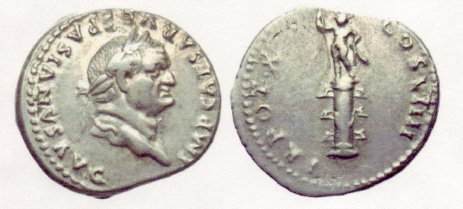
Mr Atherton's example recalls a coin struck by Augustus shown here on Wildwinds. Both of these coins present the statue and the rostral column in their entirety. The objects jutting out from the sides of the column are the bronze ramming beaks (rostra) taken from warships by Augustus at Actium, and these are what give the column its name. Note that there aren’t any gooseneck projections rising from the top of the column.
This is not what the capital of a Roman column looks like. Note also what appears to be a pictorial frieze on M2, the area directly beneath Minerva's feet. There is never a frieze on a classical column, and certainly not on the column's capital. (Furthermore what is portrayed on this frieze, a submissive figure before an enthroned figure, doesn't have anything to do with Actium since Antony didn’t surrender to Octavian.) Even Trajan's Column, which will break all the rules a generation later with a pictorial frieze wrapping around it bottom-up like a corkscrew, doesn't attempt to continue the enwrapping frieze to the very top of the column, which in fact is topped by a simple Doric capital.
This is not what rostral columns were used for. The rostral columns were built to honor the heroes of Actium and their victory at sea and to hold their statues. The rostral column wasn’t any place for a goddess to stand.
Then if not a rostral column, what is it that Minerva M2 is standing on!
In my opinion, what is depicted is an apparatus, in particular, a very specialized conveyance called a ferculum (Madigan, op.cit., p.39), a processional litter used in military triumphs and, more regularly, in the circus parade, the pompe circensis. Here is a familiar example of a triumphal, ad hoc processional litter from the Arch of Titus in Rome--
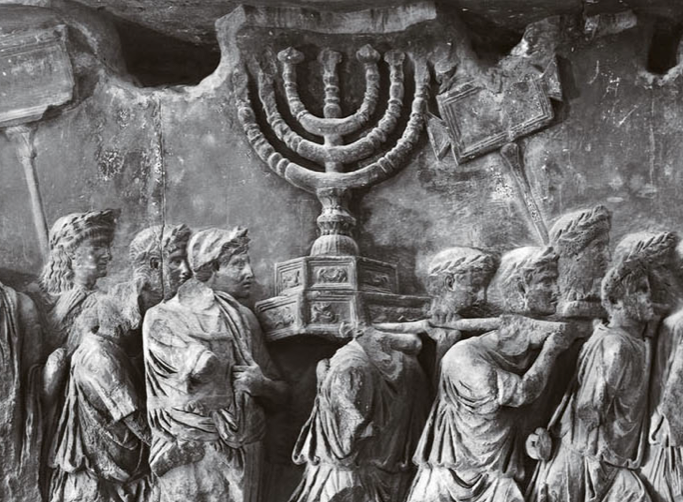
Here is another example in the Louvre (ibid., fig.20) of a ferculum used in the pompe circensis--
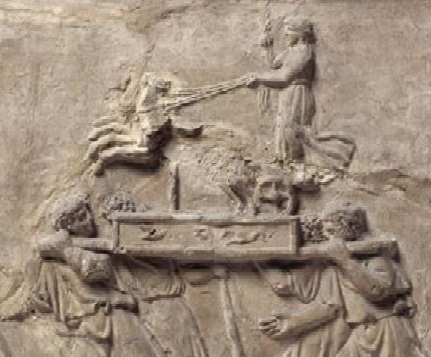
The M2 replica of the Aventine Minerva would have been carried in procession right along with the two of these. Ovid mentions spotting the goddess Minerva (in my opinion, this ἀπεικόνισμα mounted onto this ferculum) in the distance while he attempts to seduce another man’s wife--
Sed etiam pompa venit--linguis animisque favete!
Tempus adest plausus--aurea pompa venit…
Artifices in te verte, Minerva, manus!
Already the parade arrives--silence your hearts and tongues of any bad omen! It’s time to applaud--the golden parade is here... Minerva, nod to the applauding hands of your own craftsmen!
(Amores, iii, 2.43-52)
Compare the two fercula above with the M2 reverses below, RIC 730 on the left showing just the apparatus itself; RIC 427 on the right, the ferculum with (truncated) poles attached--
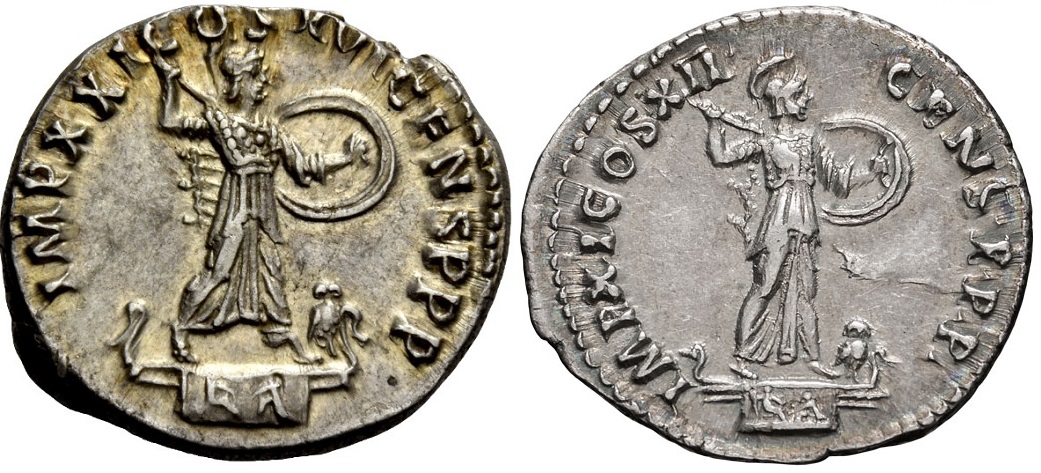
I am identifying the picture on the side of the litter with the story of Arachne, specifically Arachne presenting her cloth to Minerva for judgment. This story seems to have been especially dear to the Aventine Temple (Eve d'Ambra, Private Lives Imperial Virtues, the frieze of the Forum Transitorium in Rome, Princeton, 1993, passim). Note that the coin on the right (especially) shows Minerva enthroned; this would have been the typical representation of the goddess at home in her aedes.
Now, about the owl. Numismatically-speaking the owl isn’t necessary, neither from a practical standpoint nor an aesthetic one. It isn’t necessary to add as an attribute because everyone in Rome would have recognized this depiction of Minerva as the Aventine’s ἀπεικόνισμα, owl or no owl. It isn’t necessary as a design feature either. There really isn’t any room for it on the ferculum, and arguably the ferculum looks better without it, more balanced. It seems obvious to me that when the actual ferculum was constructed for the actual ἀπεικόνισμα the owl wasn’t included in the calculation, or else there would have been a space built in for the poor bird so that Minerva wouldn't have to be constantly tripping over it. Here is an example (RIC 690var) where the engraver omitted the owl by accident--
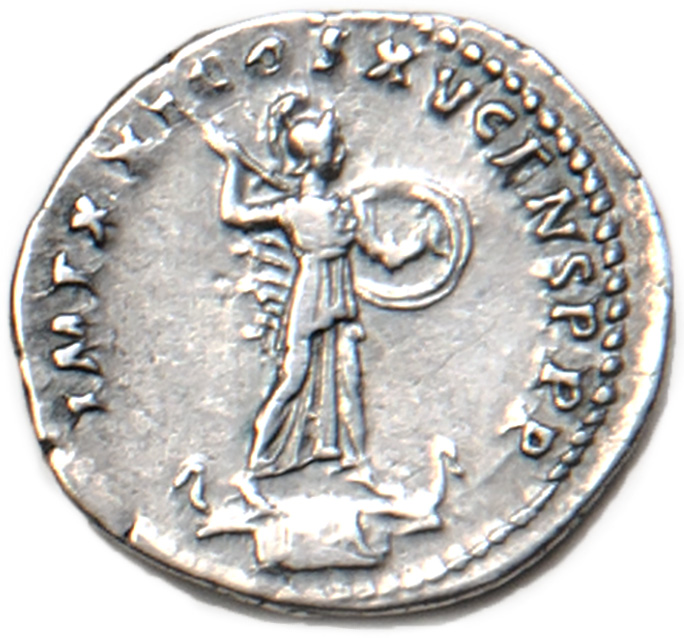
One could safely argue from a design standpoint that the coin is better off without it. I say this with some degree of confidence in so much as my university degree is in art (B.F.A.-painting, UW-E.C., 1999). But there is, in fact, an owl on the standard M2 reverse, so what is the deal with the owl?
In my opinion, something momentous must have happened in 76 or shortly before, when Domitian was only 25, something involving the owl. Romans had a superstitious fear of owls; encountering one in the daytime was particularly dreadful; to have one appear, for example, in the middle of a religious ceremony would be enough to cancel the proceedings entirely or at least to force their rescheduling for another day and only after a prolonged ritual of purification! In the case of a festival of games, which were, at their core, religious in nature, this would be disappointing for the people and expensive for the city or for the individual presenting the games.
So when this dreaded, cursed owl appeared in the early daylight hours at the beginning of one of Rome’s innumerable festivals in 76, during the all-important circus parade, the magistrates in charge were ready to throw up their hands and call it quits for the day, quits for the entire festival. This was a disaster, a total, unmitigated disaster. It was then, at the most opportune moment imaginable, that the cadet limb of the imperial family whose pronouncement carried the weight of the emperor himself, the young priest Caesar Domitian (perhaps in his role as Augur, or perhaps he was already a member of the College of Fifteen), calmly pointed out to everybody what was right before their eyes--whither the owl had lit, on the Aventine Temple’s own ferculum, at Minerva’s own feet! Here was a bird that was sacred to the goddess, despite the common wisdom about owls, her avian familiar, being called to heel at her feet! This wasn’t a disaster, my goodness! This was indeed a miraculous event! Yay! The festival could continue!
I believe that this is what happened in 76. In addition to being named Hero of the Day, this incident affected Domitian deeply. He took it as a personal sign of favor from the goddess who had visited him in dreams, a sign of his destiny, not in support of his imperial aspirations--I don’t believe that the future emperor had any imperial aspirations, not really, I don’t believe he was ever in the habit of carrying the baton of empire around in his knapsack--but in support of his literary aspirations. Domitian was already a writer of significant note, a gifted and celebrated poet and the author of a comic, self-deprecating essay on the subject of baldness and its cures. Although dedicated to craftsmen specifically, Minerva’s Temple on the Aventine was a haunt of poets and writers in Rome, and here was a miraculous intervention by that temple’s patron goddess herself.
Afterward when Domitian met with Claudius Etruscus, the director of the mint, in order to commemorate this important moment in his life with an appropriate denarius, Claudius Etruscus baulked. “Your face might be on the front, sonny-boy,” the mint director spoke with some heat, “but it’s still the imperial coinage, and we’re not about to put a circus parade prop on the back of one of your dad’s coins!” So an unsatisfying compromise was reached in RIC (V)920, shown here from the Alberto Tricarico coll.
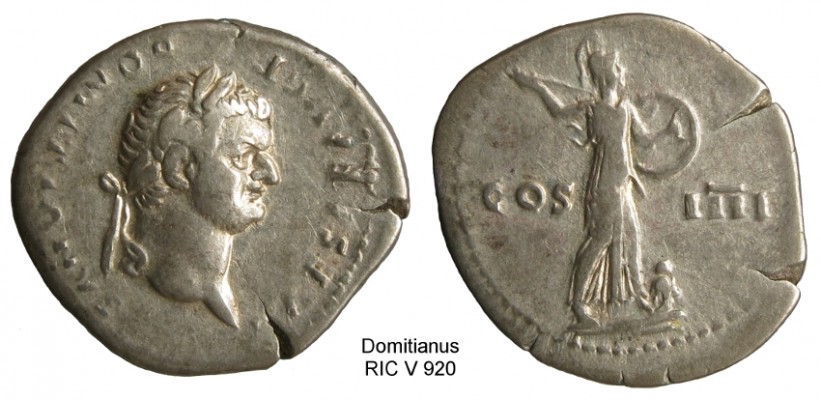
Instead of the ferculum with its gooseneck appendages (first-century visual shorthand for the deck of a warship) we see Minerva standing with the owl on the prow of an actual warship. No doubt Claudius Etruscus was able to cite precedent from the coinages of Ionian Lebedos and Lycian Phaselis (Schürmann, op.cit., p.73) in support of this half-measure.
Soon upon the occasion of Domitian’s elevation to the throne of Augustus, Claudius Etruscus was banished from Rome, perhaps having called the emperor “sonny-boy” once too often, and I will be writing about that event in some detail in next week’s blog article.* Meanwhile the owl, an actual, living owl sacred to the Aventine precinct, no doubt trained or tethered to the processional litter itself, was elevated as well, to a permanent spot on the Aventine parade ferculum. That this is so is evident in the last coin, a Judaean provincial issue (RPC 2304, both examples from my collection and between them showing all of the relevant elements).
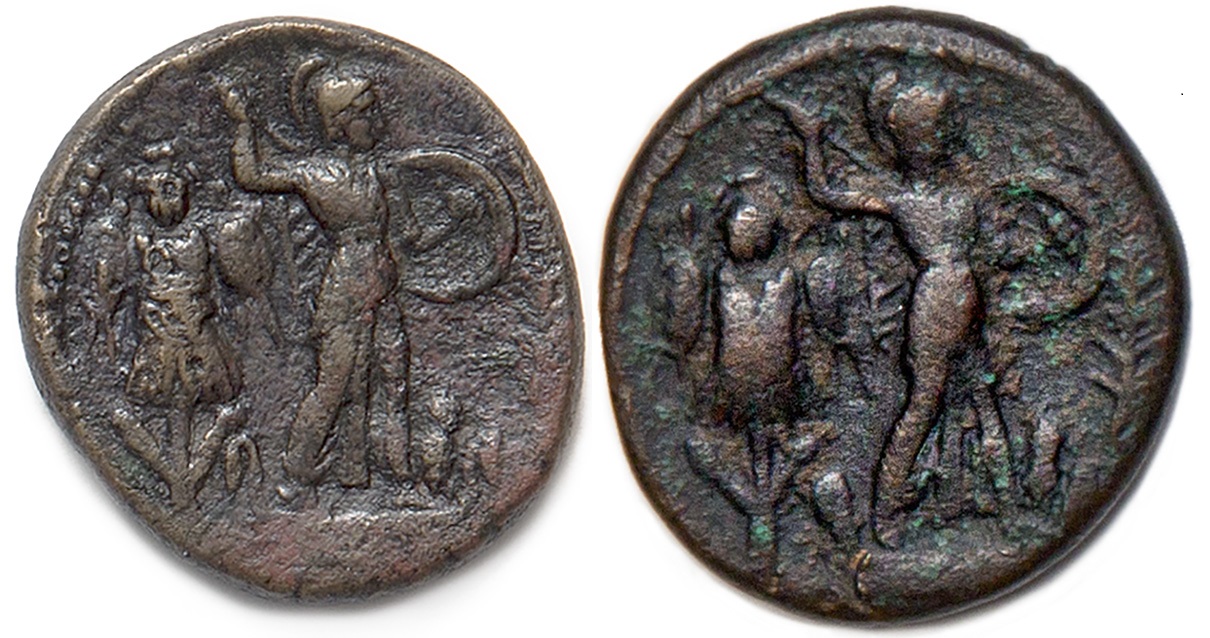
Without a new interpretation, this reverse is gibberish, an iconographic salad, however with the new interpretation the meaning is now clear. A palm branch, symbol of victory, followed by Minerva Promachus (the Aventine Minerva) on her processional litter, followed by a war trophy: This is a Roman triumph, that is, a triumphal procession as celebrated in the city of Rome, a scene familiar to any transplanted Roman living in Judaea but especially familiar to the military veterans resettled around Caesarea. To them this was a postcard from home.
*Ian Carradice has already written on the matter ("The banishment of the father of Claudius Etruscus: numismatic evidence," LCM 4.5 (May, 1979), 101-3). Everything I happen to know about the subject, including where to find it in Statius (Silvae 3.3), I learned from Prof Carradice's article after he so kindly emailed it to me. I don't expect to add anything substantial to his fine work, but I will be presenting a coin next week in this space (my "RIC Coin of the Month") that may or may not be relevant, probably "not," according to Prof Carradice. N.B., of course the title of the paper cited is correct, it is the father of Claudius Etruscus that Statius (and Martial, vii.40) eulogizes to the son, but that construction proved too cumbersome to use four times in my text; besides they probably shared the same name anyway.
Next: "RIC 113var: a case of casus belli"
Comments--
Prof Brian Madigan, Wayne State University, author of The Ceremonial Sculptures of the Roman Gods, comments--
"Thanks very much for your email, and for sharing your observations on the Domitianic coins. Let me say at the outset that I am not a numismatist, but an archaeologist who makes use of the information worked out by people like yourself and Prof. Carradice to apply to other archaeological problems. That said, let me make a few observations. The object that Minerva stands on is a very interesting problem. If it is not a ferculum, I don't know what it would be. I don't have comparanda for the goose-neck devices, but it does seem reasonable that they could be some kind of frame at the top of the ferculum. If it is a ferculum, then it does pose the problem of why the designer would feel compelled to provide something that specific for the image (as your argument itself indicates). And you are surely right to stress that the frieze on that base on the coin can be paralleled in the Campana relief in the Louvre and the arch of Titus which you illustrate. Any alternate proposal is going to have to provide an explanation for such a frieze.
"One correction, if I may. A ferculum statue and an ἀπεικόνισμα are two different species of statuary, distinct in their function. The ἀπεικόνισμα is a small statue held by a single individual. Despite its small size, there is good evidence that it could appear in large, public ceremonies. And texts also indicate that it could imitate cult statues, or sometimes other well-known images. The ferculum statue is much larger, hence the need to have a litter to carry it around, minimally so far as I can see, by four people. Its entire purpose was to be seen in these large processions. Whether a ferculum statue would reproduce a cult image is, so far as I am aware, not supported in texts. But as you yourself demonstrate, the visual evidence that this would be the case is considerable (and reasonable for on propagandistic grounds).
"There is an essay from a conference which is awaiting publication, in which I try to trace the history (and connection to cult statues) of the ἀπεικόνισμα back through its Greek heritage. If those conference papers do eventually get published, it may be of some interest. As a numismatist you may also find of interest that I have recently completed a book that examines the first publication of Roman coins in the Renaissance, assessing how the author was trying to figure these things out. I have not yet arranged with a publisher, so even the title cannot be fixed, but I trust that it will before too long see the light of day.
"Thanks again for taking the time to share your observations with me."
Prof Ian Carradice, co-author of The Roman Imperial Coinage, Vol. II, 2nd ed., comments--
"I'm not sure I'm prepared yet to forsake the rostral column explanation, but you make a good case for the alternative. Although you must be careful with treating coin depictions of buildings and monuments too literally (bearing in mind the possible necessity for engravers to resort to shorthand at times), there remains much work to be done on the identification or explanation of ancient coin types; I think, for instance that the pulvinaria series introduced by Titus may deserve more consideration."

